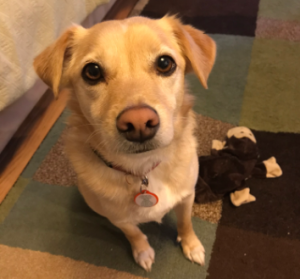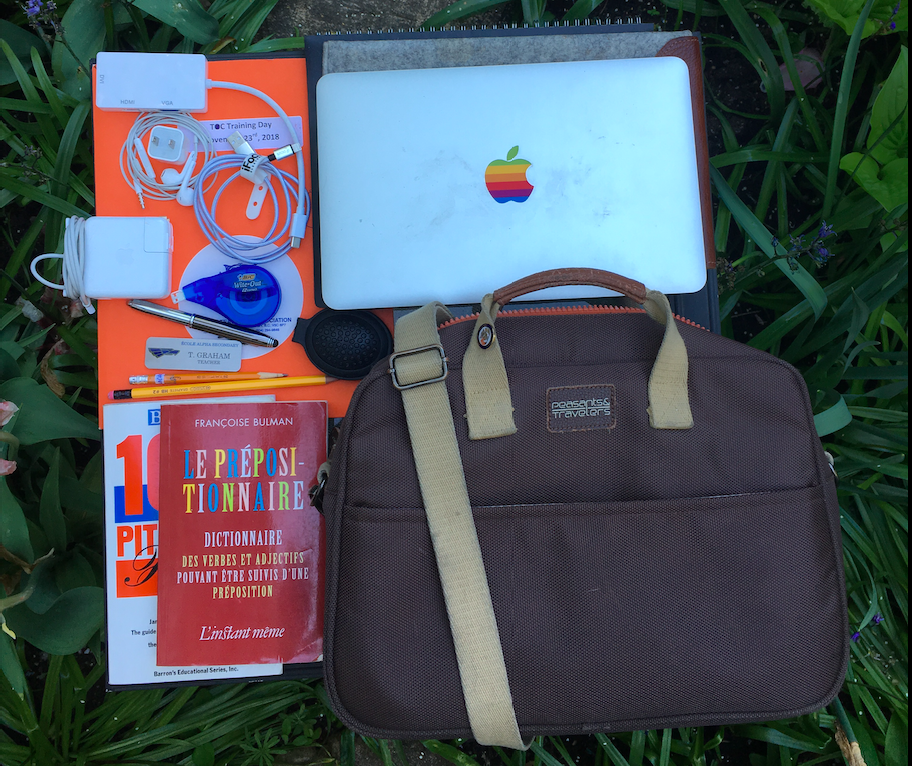Unscripted text:
In the bottom left corner of the phone away used in our first assignment for E-Tec 40, you’ll note a small ha belonging to my dog dug. For the course of rather for the past 5 years Doug become my shadow since we first adopted and a late November and afternoon from the shelter in Western Quebec. Doug is what is known as a potcake and was rescued from one of the islands We Believe st. Maarten in the Caribbean. Doug has become my shadow I think simply because I was the one to rescue him but also because I feed him and I think that he and I have similar levels of energy. Interesting to note that spot cakes I have some uniqueness and eccentricities about them that I didn’t know prior to adopting. And that they are terrified to have their hair their fur brushed if you’re full of toothbrushes and other grooming tools. If you look up pot cakes on the internet you’ll find some information there but really A lot of the information that’s has been published or is available online is based on first person experience. These. I have learned to be wary of humans and are also wary of a variety of tools that humans use for example in our house as soon as the broom comes out Doug is a and so it’s been a long journey to help him get over his fear of brooms and brushes and the lake. The story of his adult is kind of a cool one we went to the SPCA in Western Quebec just to visit a different. When my then three-year-old son in reached the SPCA they told us that the dog that we’d come to see was not good for children and we just gone to meet a couple of dogs to see whether there was one that was a good fit but really it was just the start of a process of adopting a dog for home. They suggested that we meet this very large Boxer bully cross and though she was lovely she was very powerful and drag me into the door so not a good fit; and then they told us about the giant Chihuahua. I suggested to the folks at the SPCA that giant Chihuahuas probably not a good option for my family because chihuahuas are known to be quite talkative and can be aggressive however they suggested that this one in particular was quite interested in children. Out came. Who was previously known as Rex, and he looked at me and ran straight past me for my son. When he approached my son he put his paws on my son’s shoulders and started licking my son’s face and was overjoyed he wagged his tail and was all about my son. Later that evening when we returned to introduce the dog for potential adoption purposes to my husband and also my daughter. Same thing with my daughter and it was at that moment that we knew that this dog is Anais. So fast forward 5 years and throughout my experience in the Met program Doug has been either at my feet on my lap or somewhere in the room in the vicinity of me while I write read respond to a variety of of posts and as I continue working my way through all of my courses. And today is no exception, he is at my feet curled up in a ball while I’m responding and creating this document that he knows nothing about but of course he recognizes his name as I’m speaking it. He’s become quite a member of the family and I’m pretty sure that he’s made my journey through the Met program an awful lot easier. If I’m frustrated or I just need a break he is right literally at my feet willing to help out when and where he can so that’s certainly been a positive aspect of having what I call a shadow.. I wouldn’t change a thing.
Reflection
When I reviewed the text that emerged after I used Speechnotes to record a story about my dog, Doug, I was surprised at the size of the paragraph that was produced. I realize now that I needed to divide the story up into smaller pieces (and start new paragraphs) to make it easier to follow. Without having a decent understanding of how to use speech-to-text software, it was challenging to remember to create new paragraphs and include appropriate punctuation! Thus, the resulting (giant) paragraph lacks proper punctuation, paragraph structure and the flow or fluidity one might expect when reading a text-based story. Though I managed to remember to include some punctuation (the odd period and comma), overall, the sentences are quite rambling and in some cases, nonsensical.
Overall, the gist of my story is more or less present within the paragraph created by Speechnotes; however, I either did not speak clearly enough or Speechnotes misinterpreted some of my words at key points and so the resulting sentences/thoughts that have been translated into text do not always make sense (and are inaccurate). For example, in the very first sentence Speechnotes recorded the following mistakes: “photo I” is recorded as”phone away”, “small paw” is recorded as “small ha” and “Doug” is “dug”; these are quite significant errors! These text-based alterations cause Speechnotes to paint a completely different picture of what it is I am trying to say; though the product of my speech-to-text attempt is sitting on my screen, and some of my general thoughts are present, the essence of the story and the tapestry I am trying to weave, is missing. The text is disjointed and choppy and can be more adequately referred to as a selection of words combined together in sentences rather than a story being woven together with care. Much of the diction and grammar are erroneous and make parts of sentences intelligible. So, though many words are ‘right’, much of the story itself is ‘wrong’ (and the flow of the story is ‘wrong’); the short story loses its ability to be a meaningful story through Speechnotes’ choice of words, the way in which it arranges sentences, and the software’s inability to detect the overall theme and meaning of the story. Lacking the ability to understand context and perhaps the humanity within the story, Speechnotes can only provide a series of words that closely approximate the sounds sent to the Speechnotes through the mic on my headset.
Scripting Stories
If I were to script a story rather than tell it orally, I would spend time selecting the correct words in which to convey my intended meaning. I would write a number of drafts to ensure I am telling the story correctly and that I am selecting the most appropriate words to represent what it is I am trying to say. If I had written or typed this story rather than relay the story through Speechnotes, I would also have had the opportunity to edit what I’d recorded; whereas with oral storytelling, it was a one-shot deal!
Oral Versus Written Storytelling
Oral storytelling is really an off-the-cuff experience that gives you an in-the-moment opportunity to convey your story to an audience. During Task 3, I didn’t have much of an opportunity to vet what I was going to say prior to speaking through the mic and so the probability that my words would be misinterpreted was a lot higher than I thought it would be. I imagine if I were to attempt to retell my story again or if someone else were to attempt to retell my story based on what they’d heard, it’s possible the very nature of the story would change and evolve with each retelling.
With written storytelling however, the storyteller can edit, revise, and truly capture the story they’re trying to share; they can take time to alter their diction, grammar, spelling and punctuation according to their audience. Written stories can be read and reread and the message, if clear within the story, will not change. Much of the spontaneity of an oral story is lost when choosing to write a written story instead; written stories are carefully crafted to tell a particular story (and can be retold over and over again).
There is a bit of magic in telling (and listening to) oral stories that I think can be lost in a written story. Certainly in my case though, I learned that oral storytelling (and capturing the story using speech-to-text software) is not a natural talent of mine.



